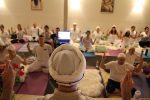Benefits of Yoga Nidra
As described in our class description, Yoga-Nidra is known as conscious deep sleep. If you have taken a yoga class before, you may have even briefly experienced this deepest form of meditative yoga where-by after completing an array of asanas (yoga poses), you relax in shavasina (corpse pose), by lying down in a deep relaxed state. But this is just the tip of the ice-berg.
In Yoga-Nidra, you are guided by the soothing and comforting voice of your teacher, while you enter into a deep sleep but still remaining conscious and aware. Understanding this practice is not as important as experiencing it. Let go and allow this ancient practice to guide you instinctively. Yoga-Nidra goes beyond ordinary relaxation and while it provides the same benefits, it does so much more. Yoga-Nidra expands your consciousness allowing for a greater sense of self awareness and a higher vantage point for a larger more complete perspective.
The practice of this meditative state has been studied since the 1970s and researchers agree that the benefits of Yoga-Nidra are substantial. Why is this so? The essence behind this ancient technology is scanning the inner body, then releasing all thought and the emotional tensions that arise out of thought. Brain waves actually are altered as a result of this practice. While the mind and body are extremely intelligent and complex systems, there is still a primitive part that continues to react to negative and automatic thoughts on a conscious and even subconscious level.
More than likely, there have been times when you mistakenly misunderstood a situation, jumped to conclusions, or experienced strong negative emotions due to the mind’s overactive storytelling. From these imaginary threats, the mind can truly trick the body into thinking it is under attack. Perhaps, there has been a time when you thought you lost something of great importance like your car keys, wallet or purse, only to find that the item was exactly where you left it. Although the item was never really lost, you experienced real emotions generated by your thoughts about the situation.
You probably felt a rush of adrenaline, increased heart rate, as well as rapid, irregular and short breathing. Such physiological changes occur to ready the body for a flight or fight response. These instinctive reactions can be helpful at the right time, but when the mind story- tells negative thoughts over and over it can have a negative impact on the body. Given these types of stressors occur every day, but perhaps on a smaller scale, there is a continuous assault on the body resulting in chronic illness and an imbalanced system. The body’s autonomic system that acts as a control center for many involuntary tasks, working below your level of consciousness, can become overworked sending it off of its natural equilibrium. Sympathetic and para-sympathetic nerves become oversensitive.
Regular sleep can rejuvenate the body, however, you are not in control of what you dream or of the thoughts and subtle emotions you may experience while asleep. This is why so many people have trouble falling asleep or have trouble remaining asleep. Some people may even sleep a healthy amount of hours, but are still tired and fatigued upon waking up. This is due to the incessant stream of negative thinking or mind-garbage.
Yoga Nidra is a conscious sleep where you are in a complete state of deep relaxation but still aware and in control of your thoughts and emotions. If fact, it is a release of all your thought and emotion. It is a cleansing of the mind. The practice of Yoga Nidra assists in returning your mind and body to its natural homeostasis and helps this natural state remain stable and constant regardless of the unending stressors we face in everyday life. Yoga Nidra will open the door to the conscious dimension of your true self and return the body’s systems back in alignment. And you might have thought yoga was just to align the spine….
In the book Pharma Sutra: Healing the Body and Mind Through the Art of Yoga, Christina Sarich writes, “It is said that a single hour of true yoga nidra is equal to four hours of conventional sleep” (2013, Loc 2073).
Yoga Nidra uses and applications
Debra E. Campbell, B.A. (Psych) (Hons), C.Y.T. (AYTC) and Kathleen A. Moore, Ph.D.
Yoga as a Preventative and Treatment for Depression, Anxiety, and Stress
In the American Journal of Psychiatry, Dr. Jon Kabat-Zinn defines ‘mindfulness’ as: conscious moment to moment awareness, cultivated by systematically paying attention on purpose.’ It is this state, both during postures and in the stillness of meditation that has been correlated with increased alpha brain-wave activation, indicating a state of deep relaxation. This may explain the effectiveness of yoga-nidra (guided relaxation) and basic meditation in assisting deep emotional release and mental balance. (Campbell & Moore, 2004, p.55)
Yogitha Bali M.R: Yoga Nidra and its Therapeutic Applications
Bali’s article, Yoga Nidra and its Therapeutic Applications, found in the Journal of Pharmaceutical and Scientific Innovation states that, “Yoga nidra has widespread applications in the management of diseases of all kinds and its affect both as a palliative and curative has been investigated in many research centers around with extremely favorable results” (2012, p.21). The article goes on to discuss a spectrum of diseases whereby yoga nidra was found to be useful in alleviating and controlling the ill effects of the diseases and conditions. Some of the conditions from the article include:
- Addiction
- Arthritis
- Asthma
- Cancer
- Cardiovascular
- Child behavioral problems
- Degenerative diseases
- Drug addiction
- Geriatric complications
- Insomnia
- Menstrual Problems
- Pain
- Prenatal and Pregnancy
- Psychiatric and psychosomatic diseases
You can find the link below to this article to read the full details and studies.
Kamakya Kumar – A Study on the Impact on Stress and Anxiety Through Yoga Nidra
Stress is a cognitive or emotional response made by the individual towards any situation, which demands adjustment. When the demands of the situation exceed the ability of the individual distress results, which may manifest in mental and physical symptoms of abnormalities. The practice of Yoga nidra helps in building up the coping ability. The practitioner of Yoga nidra slowly becomes aware of the inherent dormant potentialities and thus prevents himself from becoming a victim of distress. As yoga nidra relaxes the physical as well as mental stresses, it relaxes the whole nervous system. Stress-related disorders evolve gradually through four stages. In the first stage, psychological symptoms like anxiety and irritability arise due to over activation of the sympathetic nervous system (Kumar, 2008, 403).
Robert Nilsson- The Relaxed State and Science
In connection with an extensive research project at the university clinic in Cologne, Germany, in the beginning of the eighties, the brain waves of a group of teachers from the Scandinavian Yoga and Meditation School were measured during Yoga Nidra. A researcher who was more familiar with other and more suggestive forms of relaxation, where one imagines that one is relaxed, took part in this research. During Yoga Nidra one is not even asked to relax. The word relaxation does not appear in the instructions at all. You experience your body, its various parts, heaviness and lightness, warmth and cold… and various mental pictures and symbols. And it is this very systematic and fixed procedure that triggers the relaxation.
The researchers in Cologne found that Yoga Nidra had a more thorough effect than the relaxations based on suggestions or hypnosis. During Yoga Nidra the Alpha waves covered the whole brain, whereas they occurred only here and there during the other relaxations. Furthermore the level of Alpha waves was constant throughout the entire Yoga Nidra, while they came and went during the other relaxations. The balance between the EEG in the two brain halves was better in Yoga Nidra, which means that the two brain halves communicated better. These results were again confirmed in 1997…
(Nilsson, 1997-98, p. 7)
Just sitting quietly or, say, watching television, is not enough to produce the physiological changes. You need to use a relaxation technique that will break the train of everyday thought, and decrease the activity of the sympathetic nervous system (Dr. H. Benson as cited in Nilsson, 1998, p.8)
Links
The Relaxed State and Science-The Original Yoga Nidra compared to relaxation based on suggestion
Yoga Nidra and its Therapeutic Applications
References
Bali, Y. (2012). Yoga nidra and its therapeutic applications. Journal of Pharmaceuticals and
Scientific Innovation. Vol. 1(4), July-August 21-25. Retrieved December 5, 2013 from http://jpsionline.com/admin/php/uploads/111_pdf.pdf
Campbell, D. A. (2004). Yoga as a Preventative and Treatment for Depression, Anxiety,
and Stress. International Journal Of Yoga Therapy, (14), 53-58. Retrieved December 5, 2013 from Health Source-Consumer Edition database.
Gavalas, E. (2013). 3 yoga nidra health benefits. The Blog-Huffington Post. Retrieved December
5, 2013 from https://www.huffingtonpost.com/elaine-gavalas/yoga-nidra_b_2812676.html
Kumar, K. (2008). A study on the impact on stress and anxiety through yoga nidra. Indian
Journal of Traditional Knowledge. 7(3), 401-404. Retrieved December 5, 2013 from Health Source-Consumer Edition database.
Nilsson, R. (1997-98). The relaxed state and science. Bindu Magazine. 11, 5-7.
Nilsson, R. (1997-98). The relaxed state and science. Bindu Magazine Online, Retrieved
December 5, 2013 from http://www.yogameditation.com/Articles/Issues-of-Bindu/Bindu-11/Editorial
Sarich, C. (2013). Pharma sutra: Healing the body and mind through the art of yoga (Kindle edition).
Stankovic, L. L. (2011). Transforming Trauma: A Qualitative Feasibility Study of
Integrative Restoration (iRest) Yoga Nidra on Combat-Related Post-Traumatic Stress Disorder. International Journal Of Yoga Therapy, 2123-37. Retrieved December 5, 2013 from Health Source-Consumer Edition database.




